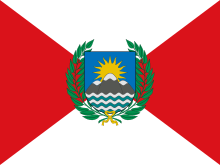Paracas district
| Paracas district | |
|---|---|
 Location of the district in the province of Pisco |
|
| Basic data | |
| Country | Peru |
| region | Ica |
| province | Pisco |
| Seat | Paracas |
| surface | 1,440.7 km² |
| Residents | 7147 (2017) |
| density | 5 inhabitants per km² |
| founding | March 8, 1951 |
| ISO 3166-2 | PE-ICA |
| Website | muniparacas.gob.pe (Spanish) |
| politics | |
| Alcaldesa district | Rosario Isabel Ramirez Gamboa (2019-2022) |
| Paracas National Reserve | |
Coordinates: 14 ° 2 ′ S , 76 ° 9 ′ W
The Paracas district ( Quechua : paraq ) is the largest district in terms of area in the Pisco province of the Ica region of Peru . The main town and administrative seat is Paracas . The area was home to the pre-Columbian Paracas culture .
The district has an area of 1440.68 km². The 2017 census counted 7147 inhabitants. In 1993 the population was 1196, in 2007 it was 4146.
Geographical location
The Paracas district extends south of the coastal city of Pisco over a length of almost 80 kilometers along the Pacific coast . The landscape consists mostly of desert. The district of Paracas is bordered by the district of Pisco to the north and by the districts of Salas , Subtanjalla and Ica (all three in the province of Ica ) to the east .
Paracas National Reserve
The Paracas Peninsula , south of Paracas Bay , and Islas Ballestas form the Paracas National Reserve , which was established on September 25, 1975 and has a total area of 335,000 hectares. The reserve, around 250 km south of Lima , is intended to protect the abundant populations of maned seals , blue-footed boobies , pelicans , Humboldt penguins and other marine mammals and sea birds. A famous landmark until August 2007 was the rock formation of the Cathedral of Paracas , which was destroyed in the earthquake in Peru in 2007 .
There is a large rock carving on the peninsula, the Paracas Candelabra , which resembles the Nazca Lines but is about 200 km south of them.
A legend tells that freedom hero General José de San Martín landed on the coast of Paracas on September 8, 1820 during his expedition . Tired from the long journey, he fell asleep on the beach. When he awoke, he was blinded by the beauty of flamingos flying by . Their outspread wings in the setting sun were the inspiration for San Martín for the first red and white Peruvian flag, which is also the model for today's national flag.
gallery
The "Cathedral of Paracas", mostly during earthquake in 2007 destroyed
Web links
Individual evidence
- ↑ a b PERU: Region Ica - Provinces & Districts . www.citypopulation.de. Retrieved January 12, 2020.







